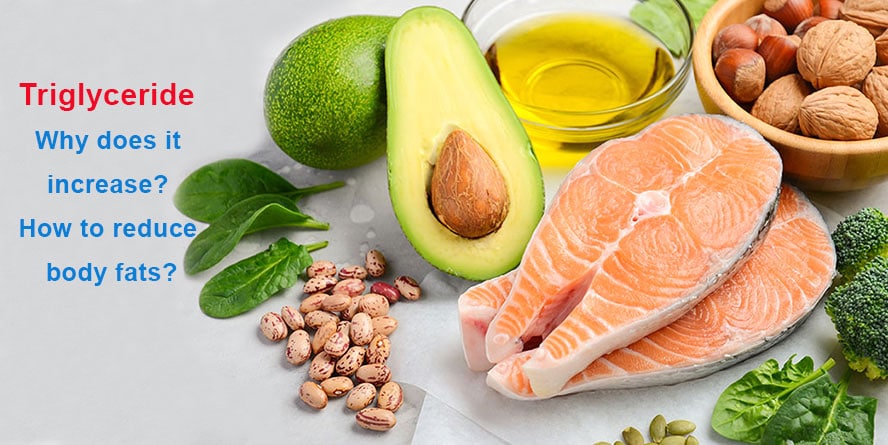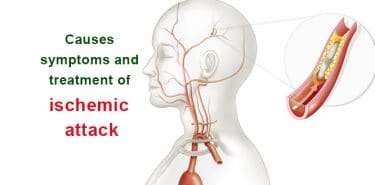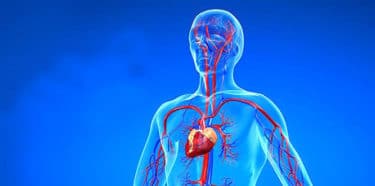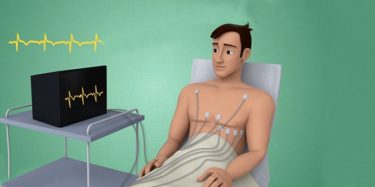Triglyceride is the most common type of fat in the body; it is the main component of vegetable and animal fats. The body converts excess calories into triglycerides, stores them in fat cells and releases them when it needs energy. Thyroid problems, obesity, uncontrolled diabetes, some genetic factors, heavy alcohol consumption, high-calorie nutrition, liver or kidney disease may cause triglyceride levels to be higher than normal. High level of triglycerides can increase the risk of heart disease, heart attack and stroke. The best way to reduce triglyceride is to live healthy. Consuming healthy, unsaturated fats instead of trans fats, reducing carbohydrate intake, regular exercise, weight control, quitting smoking, reducing sugar, refined foods and alcohol can help you reduce triglycerides in a short time.
Table of Contents
What is triglyceride?
Triglyceride is a type of fat in the blood, sometimes it is called lipid. It is the final product obtained from digestion of fats in foods. When eating, body converts calories that do not need to be used immediately into triglycerides and stores them in fat cells. Later, when extra energy is needed, hormones release triglycerides. If you consume more carbohydrate foods and get more calories than you normally spend, you may experience the problem of high triglyceride (hypertriglyceridemia). (1)
What does triglyceride do?
Because of their high carbon content, triglycerides are the best way to store energy. They play a role in delivering fatty acids to muscles and tissues for energy and burning them for energy. When the body needs energy, it releases triglycerides as fatty acids and consumes them.
Normal triglyceride levels
Triglyceride levels in the blood are measured in milligrams (mg/dL) per deciliter. Normal levels for adults are as follows:
- Normal: below 150 mg/dl
- Borderline high: 151-200 mg/dl
- High: 201-499 mg/dl
- Very high: 500 mg/dl and above

Triglyceride test
Depending on your risk factors, personal and family health history, a routine blood test called a lipid panel measures total cholesterol, HDL (good) – LDL (bad) cholesterol and triglyceride levels in the blood. Blood triglyceride levels after meals are usually higher than normal; therefore, it is recommended to look at the lipid profile after 8-12 hours of fasting.
Many factors, such as alcohol consumption, menstrual cycle, time of the day and recent exercise, can also affect levels. Levels higher than 200 mg/dL increase the risk of heart attack, stroke and death. High triglycerides is diagnosed at levels above 500 mg/dL.
High Triglycerides
High triglycerides is a type of lipid disorder. It may also be a sign of other conditions that increase the risk of obesity, metabolic syndrome, heart disease and stroke. (2)
What is high triglycerides?
High triglycerides is also known as hyperlipidemia, hypertriglyceridemia, dyslipidemia and lipid disorder. It is a disorder associated with an increased risk of atherosclerotic cardiovascular disease.

Causes of high triglycerides
- Getting more calories than you burn
- Consuming too much carbohydrates, processed food, sugar and fat
- Being fat
- Smoking and alcohol consumption
- Some genetic disorders affecting body fat conversion
- Thyroid diseases (hypothyroidism)
- Insulin resistance and type 2 diabetes (3)
- Liver and kidney diseases
- Metabolic syndrome
- Not physically active
- Some drugs used in the treatment of breast cancer, high blood pressure, HIV and other diseases (diuretics, estrogen, progestin, retinoids, steroids, some birth control pills, beta blockers, antipsychotics, corticosteroids)
What problems does high triglycerides cause?
Some triglyceride-rich lipoproteins contain cholesterol. This may lead to the stiffness of the arteries and thickening of the arterial walls (arteriosclerosis). This increases the risk of stroke, heart attack and coronary heart disease. Very high levels can lead to pancreatic inflammation (acute pancreatitis), which causes severe pain in the abdomen.
Symptoms of high triglycerides
High triglycerides usually does not show any symptoms; therefore, having a routine blood test to check your cholesterol and triglyceride levels helps protect against illness. Clinical signs of high triglycerides include ischemic vascular disease, acute pancreatitis, and significant lipid accumulation.
How to reduce high triglycerides?
- Reduce the amount of calories you eat by controlling portion sizes. Extra calories are converted to triglycerides and stored as fat.
- Research shows that regular meals can reduce the risk of heart disease and prevent insulin resistance. Eat often and little, if possible, do not skip meals.
- Exercise regularly and participate in physical activities. (4)
- Avoid sugar and refined carbohydrates. (5)
- Lose weight and exercise regularly.
- Prefer vegetable oils such as olive oil and canola oil.
- Limit processed and fried foods to reduce trans fat consumption.
- Reduce alcohol and quit smoking.
- Add fiber to your diet consisting of fruits, vegetables and whole grains.
- If lifestyle changes are not sufficient to lower triglycerides, your doctor may prescribe medications such as fibrates, omega-3 (fish oil), niacin or statins.
- If your triglyceride levels are high, you may need to take medications as well as lifestyle changes. (6)
Triglyceride diet plan
Mediterranean diet is usually advised to reduce triglycerides. This diet is based on the limitation of carbohydrates and the consumption of unprocessed foods with a low glycemic index containing high levels of healthy fat.
- Limit consuming saturated and trans fats; opt for unsaturated healthy fats.
- Eat fiber rich carbohydrates and limit consuming refined carbohydrates (white bread, pasta, potatoes, rice).
- Eat foods rich in omega-3 fatty acids present in fish, fish oil and some plants instead of red meat. Choose fatty fish for two or more meals a week.
- Avoid simple sugars (cola, fruit juices, chocolate)
- For dessert, instead of pastries, choose fruits such as blueberries, blackberries and raspberries.
- Natural sugars such as honey and molasses can increase your triglyceride level when consumed too much.
What are the best foods to eat to lower triglycerides?
- Whole grain foods: Oats, barley, corn, rice, wheat, whole wheat pasta, brown rice
- Fatty fish: salmon, tuna, sardine, mackerel, herring and trout
- Omega 3: Plant based omega-3 forms such as soy food and flaxseed
- Unsaturated fats: Olive oil, hazelnuts, canola and avocado oil
- Nuts: Almonds, Hazelnuts and Walnuts
- Fiber-rich legumes such as beans and carob
- Tomato, carrot, leek, garlic, onion,
- Leafy vegetables such as cabbage, purslane, broccoli and lettuce
- Sage, sunflower, thyme, frankincense, mint
High triglycerides and heart disease
Triglycerides is important criterion of heart health. It is linked to the possibility of having a heart attack or stroke. Very high triglycerides often comes up with the following and may pave the way for serious cardiovascular problems: (7)
- Low levels of good (HDL) cholesterol that remove cholesterol from the blood
- Bad (LDL) cholesterol that can accelerate atherosclerosis
- Some changes in the body’s ability to dissolve blood clots
- Metabolic syndrome
What is the relationship between triglycerides and cholesterol?
Lipids are the fats in the body. The main lipids in the bloodstream are cholesterol and triglycerides. They play a crucial role in building and maintaining essential parts of cells, such as cholesterol, cell membranes, and making several essential hormones, including estrogen, progesterone, vitamin D, and steroids.
Triglycerides, chains of high-energy fatty acids, provides most of the energy required for tissues to function. So you can’t live without cholesterol and triglycerides.
The level of triglycerides in blood is as important as cholesterol levels in case of heart diseases. High levels of triglycerides in combination with high LDL (bad) cholesterol or low HDL (good) cholesterol are associated with fat accumulation in artery walls; this increases risk of heart attack and stroke. HDL and triglycerides are often inversely related: as triglycerides rises, HDL decreases.
What are natural fats in the body?
Fats stored in the body balance the body temperature, protect the internal organs, and meet energy needs. There are two different types of adipose tissue in our bodies that are different in terms of location, structure, color and quality: brown and white/yellow fat cells.
- White/yellow fats: They store energy and support our internal organs. Their colors may vary from white to dark yellow, depending on the presence of carotenoids (vitamin A), which usually dissolve in the fat droplets of cells. Almost all of the adipose tissue seen in adults is of this type.
- Brown adipose tissue has a more limited distribution than yellow fats that are present all over the body. The function of brown fats that are activated in the cold is to produce heat and to burn calories at the same time. It is very important in the first months after birth, because it protects the newborn baby against the cold.
How to reduce body fat?
Fats are just as important as carbohydrates and proteins. Consuming a certain amount of fat is very necessary for your health, because some vitamins need fats to be absorbed by the body. Lipoidosis occurs when we gain extra calories. Consuming too much protein and carbohydrates can also lead to lipoidosis.
Therefore, counting calories is recommended by many dietitians. The best thing to do is to exercise regularly, pay attention to your sleep, avoid stress and follow a balanced diet where you consume a high amount of fiber.
- The most favorite methods of fat burning are cardio and weight training. Recommended for those who do not have any medical disability and need to burn too many calories.
- There are approximately 8-9 calories in 1 g fat. Consuming plenty of fruits, vegetables, whole grains, legumes, nuts and seeds; limiting intake of saturated fats from meat or dairy products can reduce calories, but help maintain a balanced diet.
- You can reduce sugar intake by using spices such as cinnamon or ginger to add flavor to foods and by drinking water instead of sugary drinks.
- If you are overweight, losing weight can help you get rid of excess fats.
- There are also medical methods that can be applied to remove body fat with such methods as cryolipolysis, ultrasound (HIFU), radiofrequency and injection lipolysis.
- Unrefined carbohydrates are good sources of fiber, but also provide faster and longer lasting fullness than refined carbohydrates, because they release their energy more slowly. For more: >>> Triglycerides




